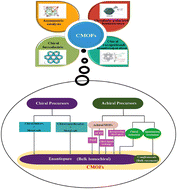A review on chiral metal–organic frameworks: synthesis and asymmetric applications
Abstract
Chiral metal–organic frameworks (CMOFs) have the characteristics of framework structure diversity and functional tunability, and have important applications in the fields of chiral identification, separation of enantiomers and asymmetric catalysis. In recent years, the application of CMOFs has also been extended to other research fields, such as circularly polarized fluorescence and chiral ferroelectrics. Compared with achiral MOFs, the design of CMOFs only considers the modes of introduction of chirality, and also takes into account the crystallization and purification. Therefore, the synthesis and characterization of CMOFs face many difficult challenges. This review discusses three effective strategies for constructing CMOFs, including direct synthesis of chiral ligands, spontaneous resolution of achiral ligands or chiral template-induced synthesis, and post-synthetic chiralization of achiral MOFs. In addition, this review also discusses the recent application progress of CMOFs in chiral molecular recognition, enantiomer separation, asymmetric catalysis, circularly polarized fluorescence, and chiral ferroelectrics.

- This article is part of the themed collection: Recent Review Articles


 Please wait while we load your content...
Please wait while we load your content...